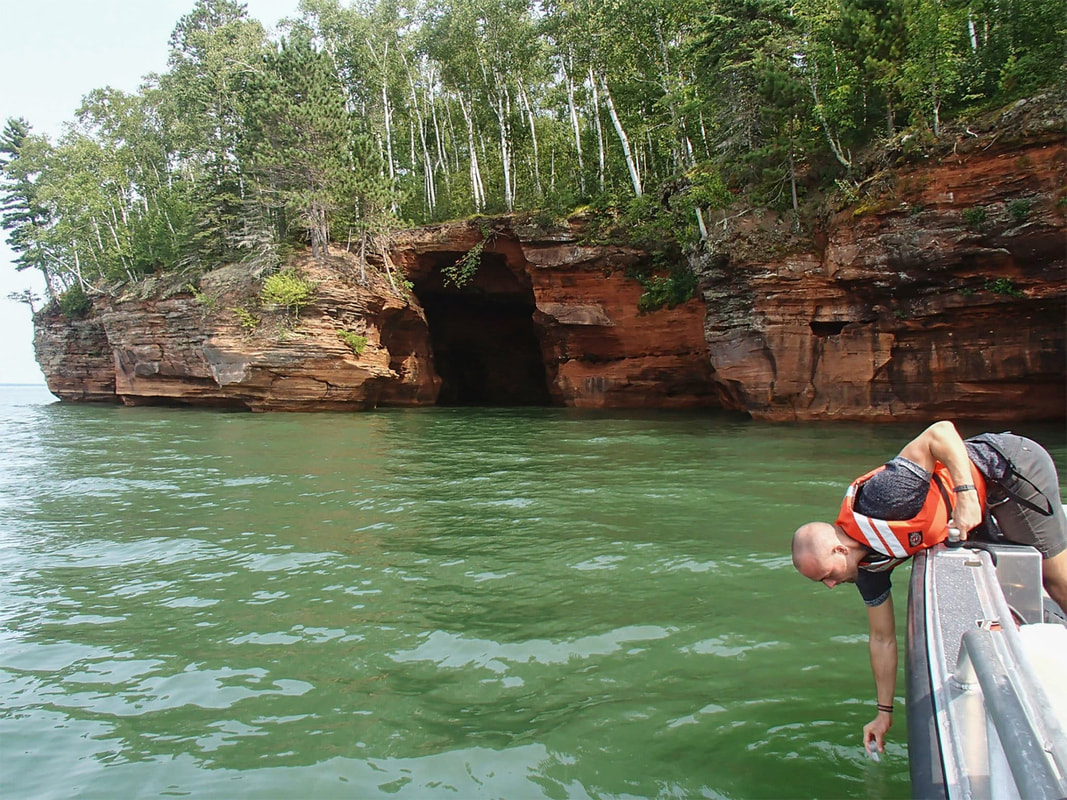The kayakers stood on the beach, marveling at the clear sweep of blue. The twin sisters from Chippewa Falls, Wis., were fresh off their first trip through the sea caves of the Apostle Islands National Lakeshore.
"I would never have guessed it would have happened here," said Jessie Rubenzer, with a glance toward Lake Superior. "It's all perfect beach," Rubenzer said. And, said Short, "Perfect water." When it's not green.
A bloom of blue-green algae, or cyanobacteria, first appeared in Lake Superior about a decade ago, leading scientists to ask why the problem was surfacing in a lake that holds a tenth of the earth's surface freshwater.
The blooms, which have cropped up in all the Great Lakes, can deplete oxygen and cut off light, harming organisms trapped underneath. They sometimes create toxins that threaten the health of fish, dogs and humans, and make their way into water intakes. How and why toxins accompany some blooms is still a mystery.
Since the first reported Lake Superior bloom in 2012, no serious levels of toxins had been confirmed. That changed last month with a bloom near Superior, Wis., that left a beach's water streaky green.
A toxin more potent than cyanide was detected just beyond the level set for safe swimming by the U.S. Environmental Protection Agency.
Lake Superior, among the world's fastest-warming freshwater bodies, has increasingly borne the force of what used to be considered once-in-a-lifetime storms. Weather extremes fueled by climate change may imperil a lake whose reputation rests on its unspoiled water.
Algae blooms are generally driven by temperature, sunlight, water conditions and nutrients — primarily phosphorus, which can come from farm fertilizer and manure that eventually wash into lakes.
But among the Great Lakes, Lake Superior is an anomaly.
Unlike Lake Erie and Green Bay in Lake Michigan — warmer, shallower and surrounded by sources of agricultural runoff — Lake Superior is cold, deep and nutrient poor. Blooms have appeared in northern Canadian waters, but most span a popular recreational stretch from Duluth to the Apostle Islands, where land cover is largely forest and woody wetlands; agriculture and urban detritus are minimal.
"The data have convinced me that the changing climate system has pushed Lake Superior into a new state, one where we get these blue-green blooms," said Robert Sterner, the director of the Large Lakes Observatory at the University of Minnesota Duluth. "We really owe it to the world to try to understand this circumstance as best we can."
This summer, a boost in funding for research came from the Cooperative Science and Monitoring Initiative, an ongoing binational survey of the Great Lakes. All summer, scientists from local universities and state and federal agencies have been out on the lake and in the lab, collecting, filtering, testing — and hoping the water tells a story.
In September, Hannah Ramage, monitoring coordinator with the Lake Superior National Estuarine Research Reserve in Superior, Wis., noticed the toxic bloom at Barker's Island, off Superior, where it looked like someone had dumped bright green paint.
She also spotted some beachgoers with dogs and offered a warning: "You might want to stay out of the water."
About 60 miles east of Barker's Island, the sea caves of the Apostle Islands National Lakeshore are a good reason to visit Lake Superior — when the water by Meyers Beach, in Wisconsin's Bayfield County, is clear.
In 2018, Brenda Moraska Lafrancois, aquatic ecologist with the National Park Service, heard of an unusual sight along the national lakeshore, which includes nearly two dozen islands and a 12-mile stretch around the Bayfield Peninsula.
Populations of blue-green algae exploded. That August bloom, lasting days, covered more than 50 miles from the Duluth area to the eastern Apostle Islands. Sediment plumes lingered for weeks.
If one of the world's largest lakes is showing these kinds of unexpected changes, Lafrancois said, "that's something that's worth paying attention to."
Larger blooms have occurred in years with above average temperatures and heavy rains capable of carrying loads of nutrients to the lake.
In June 2012, an intense storm unloaded 10 inches of rain around Duluth. A few weeks later, a filmy, green stretch spanned more than 12 miles of Lake Superior from Cornucopia, Wis., to Little Sand Bay. Six years later, another historic storm hit.
About a month and a half after that, so did a massive bloom. "The years we've seen the biggest blooms in the past, these are years that have major storm events and flooding," Lafrancois said. "And they're years with warm temperatures. And we know just based on climate change models and so forth that we're kind of stacking the decks in favor of those types of conditions."
Rising temperatures, diminishing ice cover and longer summer seasons don't bode well for the rapidly warming lake. This summer, Lake Superior saw aboveaverage surface water temperatures, according to National Oceanic and Atmospheric Administration data. Mid- October temperatures are the warmest on record since 1995, still hovering near 60 degrees.
The Great Lakes region overall has seen a nearly 10% increase in annual precipitation in the last century, and more regularly through intense storms, with that trend projected to continue.
Sterner, the Large Lakes director, said he worries about protecting Lake Superior as a cultural resource. "I think about people who maybe planned all winter for a kayak trip, and they showed up, and ... saw murky green water that looks like melted crayon. Well, they didn't plan all winter for that." He added, "So I worry about that, because I love this place."



 RSS Feed
RSS Feed